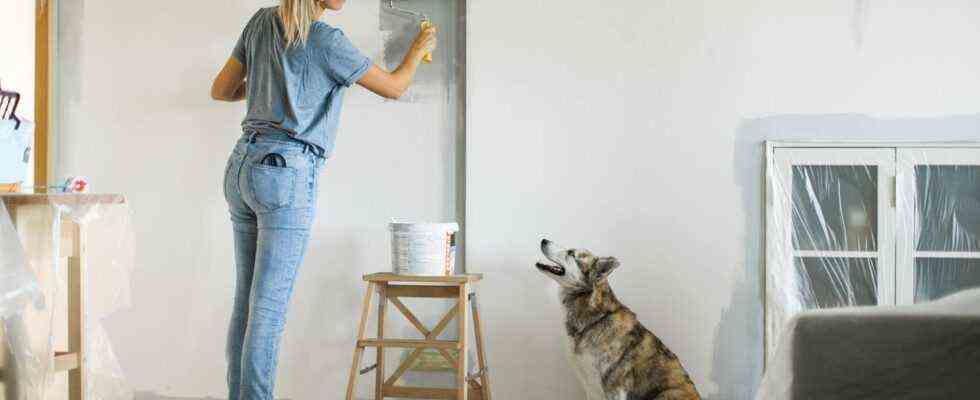Painting work
Do you want to paint your living room? These are the most important steps
A new coat of paint breathes new life into the living room
© svetikd / Getty Images
The living room needs a new coat of paint every now and then: if the wallpaper looks faded or if a move is imminent, reaching for the paint bucket can hardly be avoided. Before you start painting, you should prepare well. Here you can find out what needs to be considered when painting.
Table of Contents
Before you start painting the living room, you should know roughly how much paint will be needed. In order to calculate the consumption, the walls (including the ceiling) must be measured. On the paint cans you will find the exact information for how many square meters the content is sufficient. Bear in mind here that a second coat of paint may be necessary or that small repairs are pending. Once you have found out how many liters are needed for your living room, you should think about the paint. Which wall color is best for the room? And what accessories are required? The most important questions are answered below.
First steps: You have to consider this in advance
1. The preparations
- You make the painting work a lot easier if everyone (or at least the little ones) Furniture can be temporarily stored in another room. If that is not possible, move the furnishings to the center of the room and protect them with Cover sheet. In any case, it is important that the walls are exposed for painting.
- Then it starts Masking of baseboards and sockets, window frames and doors. Use a special one for this Painter’s tapethat protects every corner and edge from paint drops and splashes. Then it is the turn of the floor: Use a tarpaulin to protect the parquet and carpet, laminate or floorboards from the paint on the wall.
- Before painting the living room, remove all nails and screws from the walls. For an even result, you should use the visible ones Holes (which are no longer needed) or also possible Cracks with something Filler to fill. However, wait until the mass has dried before starting the first brush stroke.
- Get what you need equipment for painting, such as small and large Paint roller for the walls and a telescopic pole for the ceiling. A long ladder is also very useful in old apartments. In addition, there are round-shaped brushes for small areas and flat ones paint brush especially practical for corners.
2. The underground
If you don’t have wallpaper on your walls, you should use the plastered surfaces Prime before painting. The so-called Plaster base contains no solvents and is therefore low in odor. It evens out unevenness and ensures that the subsurface’s absorbency is reduced. So that the paint adheres better to the walls.
Most Wallpaper can be easily painted over. However, if these have a particularly coarse structure, the paint may not stick to them evenly. In this case, the glued-on sheets must be removed. If these cannot be removed, you can get one Hedgehog roller including the wallpaper stripper.
3. The wall color
- According to the current living trends in 2021, pastel tones are currently in fashion. If you want to paint your living room, you can – in addition to classic white – also use a modern emulsion paint in Mint or Lemon macaron, Dusky rose or Coffee Cream to attempt. It has high coverage, is breathable and has little odor.
Repainting the living room: Here’s how to do it
So that the paint can dry faster, it is best to open the windows while you are painting the living room. If it is too cold for that, you can ventilate the room (well) even after painting. And what else should you watch out for?
These are the most important steps:
- First paint the ceiling and then the walls so that no stains or splashes of paint land on the freshly painted sides.
- Then take a flat brush in your hand and paint all the edges, corners and edges in the living room.
- Now it’s the turn of the large areas: Use a large paint roller here and paint the walls evenly, strip by strip.
- Smooth out any irregularities before the paint begins to dry. You can then carefully peel off the painter’s tape.
- Let the paint dry for at least 12 hours before moving the furniture back to the walls and hanging the pictures.
- After painting, ventilate thoroughly so that the paint fumes from the living room can escape more quickly.
You might also be interested in:
This article contains so-called affiliate links. Further information are available here.

